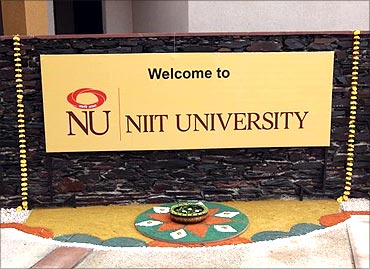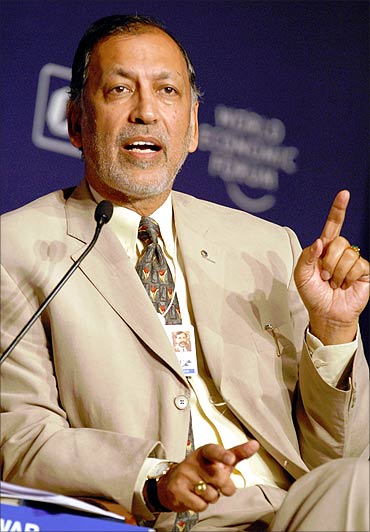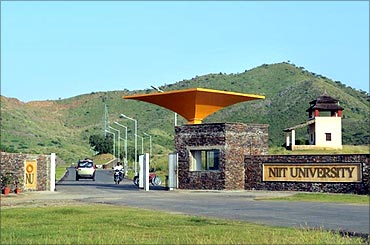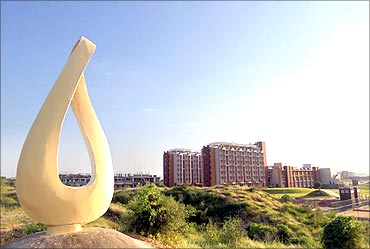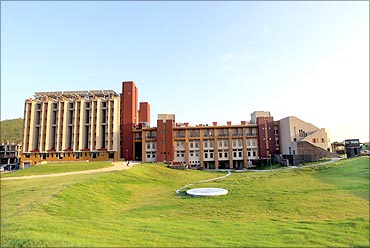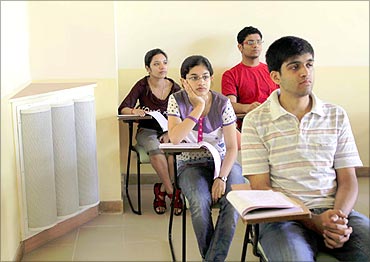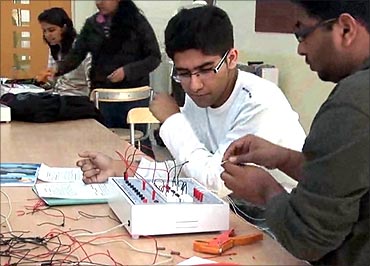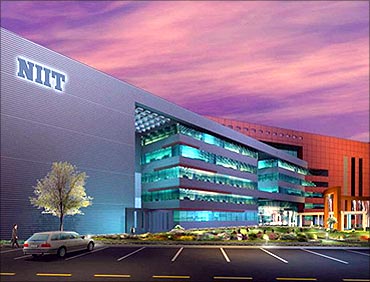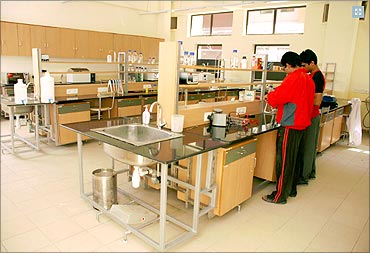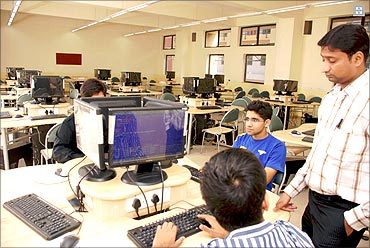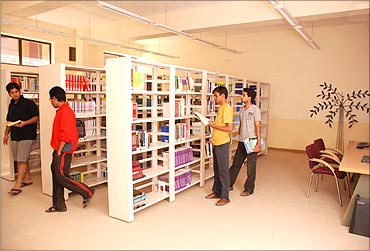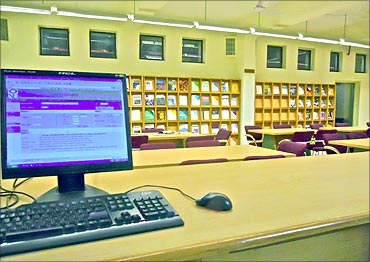 | « Back to article | Print this article |
NIIT's big plan: Teach one billion students!
The hundred acres of land, on the road from Delhi to Jaipur, were marked in government records as banjar (barren) and beehad (inhospitable). Yet, the uneven patch has been fenced and parts of it landscaped in the last two years. Dams have been built on the adjoining hills to keep flash floods, which happen during the monsoon rains, from entering the campus.
An old jaal pilu tree, devastated for fodder and firewood by villagers and nomads, has been resurrected; a road meant to run over the old tree now gently curves around it.
Photographs, courtesy: NIIT University.Click NEXT to read on...
NIIT's big plan: Teach one billion students!
This is where Rajendra Pawar, the chairman of NIIT, wants to give shape to his dream project, the NIIT University.
There are 122 students studying engineering and business administration at the university.
Click NEXT to read on
NIIT's big plan: Teach one billion students!
Pawar knows that building the brand equity of an educational institution takes time - a problem that also crops up when he goes out to recruit faculty.
But he has a 10-year construction plan for the University, at the end of which, he hopes, there will be 5,000 students on campus.
Midway, he hopes the university will have proven that it can sustain itself financially through fees, grants, incubators and sale of intellectual property.
Click NEXT to read on
NIIT's big plan: Teach one billion students!
Another duct, fitted near the ceiling, sucks out all hot air in the room. Ninety-seven per cent of the water (struck at a depth of 300 ft) is recycled.
Click NEXT to read on
NIIT's big plan: Teach one billion students!
A nursery has been set up for local trees, some of which, like the jaal pilu, face extinction. Pawar has sought the state's permission to green the neighbouring Aravalli hills.
Click NEXT to read on
NIIT's big plan: Teach one billion students!
It set up centres across the country and offered consultancy to companies.
Out of consultancy was born the software division of NIIT, Pawar's recent success. In the 1990s, the software division stayed away from the high-volume and low-margin sectors like body-shopping and Y2K.
That's why it never had the scale of companies like TCS, Wipro and Infosys.Click NEXT to read on
NIIT's big plan: Teach one billion students!
Almost 55 per cent of the business came from three verticals - travel & transport, BFSI and a mix of manufacturing and supply chain. These became the three chosen verticals.
The contribution of the other verticals has come down from 45 per cent to 12-15 per cent now. "The strategic choice had an element that was shrinking - that was a drag. Not any longer," says Pawar. "Our (profit) margins are Tier 1 margins."
Click NEXT to read on
NIIT's big plan: Teach one billion students!
While NIIT reported consolidated income of Rs 1,248 crore (and operating profit of Rs 67.20 crore) in 2010-11, NIIT Technologies closed the year with Rs 1,232 crore (operating profit of Rs 240 crore).
The reason, says Pawar, is that IT education still has a large contribution from emerging markets, though he has tried to move it up the value chain with acquisitions in the US.
Click NEXT to read on
NIIT's big plan: Teach one billion students!
"On customer satisfaction, placement and student performance, our matrix has remained very good. It's not an easy business because everyone has a personal experience. There are few institutions in the world that deal with both scale and quality."
Click NEXT to read on
NIIT's big plan: Teach one billion students!
Another criticism that NIIT now faces, after the Infosys affair, is succession: who next, after the promoters?
While Pawar is the chairman of NIIT as well as NIIT Technologies, Thadani is the CEO of NIIT and Rajendran its COO, though Arvind Thakur, a professional who joined NIIT in 1985, is the CEO of NIIT Technologies.
Click NEXT to read on
NIIT's big plan: Teach one billion students!
His targets sure are ambitious. "Three million people have benefitted from our training programmes. What next? An idea doing the rounds is 'teach a billion'.
I don't know when it'll happen; maybe a decade from now," says Pawar.
Click NEXT to read on
NIIT's big plan: Teach one billion students!
The next logical step was the NIIT University. "We see ourselves as a global talent developer, rather than just an IT trainer for developing markets," says Pawar.
NIIT University is a non-profit company; so the money, though Pawar refuses to disclose how much, has come from the personal wealth of the founders and not NIIT - it would have been unfair to the shareholders of the company.
NIIT's big plan: Teach one billion students!
At a time when there is growing disillusionment with the quality, and hence the employability, of engineers and MBAs turned out by colleges and universities, how does Pawar plan to make a difference?
The university, says Pawar, stands on four core principles: strong links with industry, technology-based education, research-driven mindset and seamless interface between various departments.
Click NEXT to read on
NIIT's big plan: Teach one billion students!
Some thought has also gone into designing the courses. The courses chosen for engineering, for instance, focus on emerging trends in a knowledge economy; thus, civil engineering is out.
Pawar has got nine of his friends, each a high-profile CEO, to mentor three or four students each. In addition, mid-level managers have been invited to act as coaches to students - they are in constant touch over email. "It helps them to keep in touch with youngsters," says Pawar.
Click NEXT to read on
NIIT's big plan: Teach one billion students!
At the end of the four semesters (two each at the University and ICICI Bank), all the students will get placed with ICICI Bank. More such partnerships, says Pawar, could happen in the future. To make a name, in the arid Aravallis, is anything but easy.
